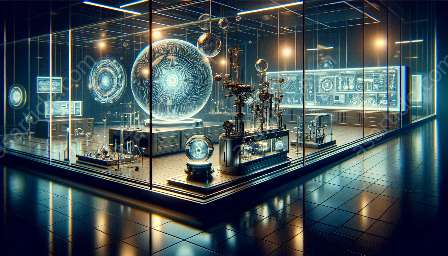Holographic measurement and testing have penetrated various scientific and industrial sectors as innovative and advanced technologies. In this topic cluster, we will delve into the in-depth concept of holographic measurement and its compatibility with holography and optical engineering, exploring the various techniques, applications, and advancements that are shaping this intriguing field.
Understanding Holographic Measurement and Testing
Holography is a technique that is used to create a three-dimensional image of an object through the interference of light beams. This technology has found widespread applications in different fields, including engineering, medicine, and art. Holographic measurement and testing, in particular, focus on utilizing holographic techniques to measure and test various physical parameters and properties.
Holographic measurement and testing serve as a non-invasive and highly accurate method to analyze and inspect objects or structures. These techniques provide detailed and comprehensive information about the objects being analyzed, making them invaluable in research, quality control, and industrial applications. These innovative technologies have significantly impacted fields such as material science, automotive engineering, aerospace, and biomedical engineering.
The Compatibility with Holography
To understand the compatibility of holographic measurement and testing with holography, it is essential to recognize the fundamental principles of holography. Holography relies on capturing the interference pattern of light waves scattered from an object. This interference pattern, when illuminated with coherent light, produces a three-dimensional representation of the object, known as a hologram.
Holographic measurement and testing leverage the principles of holography to enable precise and accurate measurements of various physical parameters. These measurements can include displacement, strain, vibration, and shape analysis, among others. By utilizing holographic techniques, such as digital holography and holographic interferometry, engineers and researchers can obtain detailed quantitative data about the behavior and characteristics of objects under study.
The compatibility with holography allows holographic measurement and testing to offer non-contact and non-destructive evaluation of objects and structures. This is particularly advantageous in industries where ensuring the structural integrity and performance of components is critical, such as in aerospace and automotive manufacturing.
Relation to Optical Engineering
Optical engineering plays a crucial role in the development and implementation of holographic measurement and testing systems. Optical engineers design and optimize the optical components and systems used in holography and holographic measurements. Their expertise is instrumental in ensuring the accuracy and reliability of holographic systems, as well as in developing advanced imaging and measurement techniques.
Optical engineers are involved in the design of holographic setups, including the selection of appropriate lasers, spatial light modulators, and imaging sensors. They are also responsible for developing specialized optics for holographic measurement applications, such as lenses, beam splitters, and reference mirrors. Additionally, optical engineers contribute to the development of signal processing algorithms for holographic data and the integration of holographic measurement systems into industrial and research environments.
Furthermore, the collaboration between optical engineers and experts in holography and holographic measurement has led to advancements in optical coherence tomography, digital holographic microscopy, and holographic metrology, expanding the capabilities and applications of holographic techniques in various scientific and industrial domains.
Techniques and Applications
The field of holographic measurement and testing encompasses a wide range of techniques and applications that have revolutionized scientific research and industrial practices. Some of the notable techniques include:
Holographic Interferometry
Holographic interferometry is a powerful technique used for measuring small displacements, deformations, and vibrations in objects. It involves creating interference patterns between a reference beam and an object beam, allowing for precise measurements of changes in the object's shape or movement. This technique finds applications in structural analysis, non-destructive testing, and fluid dynamics research.
Digital Holography
Digital holography involves the recording and reconstruction of holograms using digital sensors and computational methods. This technique enables the accurate measurement of object displacements, surface profiles, and optical phase distributions. It has diverse applications in microscopy, metrology, and particle characterization, making it a versatile tool in various scientific disciplines.
Holographic Metrology
Holographic metrology encompasses measurement and inspection techniques utilizing holography for dimensional analysis, surface roughness characterization, and quality control. It offers high precision and accuracy in assessing the geometric properties of objects, making it indispensable in manufacturing, precision engineering, and semiconductor industries.
Holographic Shearography
Holographic shearography is employed for detecting defects and stress concentrations in materials and structures by analyzing the surface displacements caused by internal or external forces. This technique is utilized in non-destructive testing of composites, aerospace components, and mechanical assemblies, ensuring the integrity and reliability of critical engineering systems.
Advancements and Future Outlook
The field of holographic measurement and testing continues to experience significant advancements driven by technological innovations and interdisciplinary collaborations. The integration of artificial intelligence and machine learning algorithms has enhanced the automated analysis and interpretation of holographic data, enabling faster and more comprehensive inspection processes.
Furthermore, the miniaturization of holographic measurement systems has led to their integration into portable devices, expanding their deployment in field applications such as remote sensing, environmental monitoring, and medical diagnostics. These developments are poised to further broaden the impact of holographic measurement and testing across diverse domains, including healthcare, environmental science, and infrastructure monitoring.
Conclusion
In conclusion, holographic measurement and testing represent a cutting-edge field that harnesses the principles of holography and optical engineering to enable precise and non-invasive analysis of objects and structures. The compatibility of these techniques with holography provides a solid foundation for their widespread adoption in scientific research, industrial inspection, and quality assurance processes. With ongoing advancements and interdisciplinary collaborations, holographic measurement and testing are poised to play an increasingly significant role in addressing complex challenges across multiple domains, driving innovation and progress in the realms of science, engineering, and beyond.

